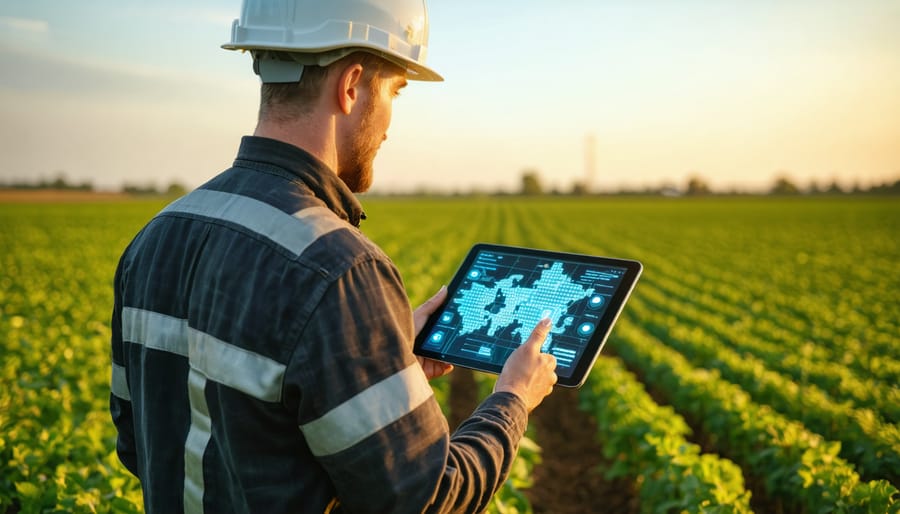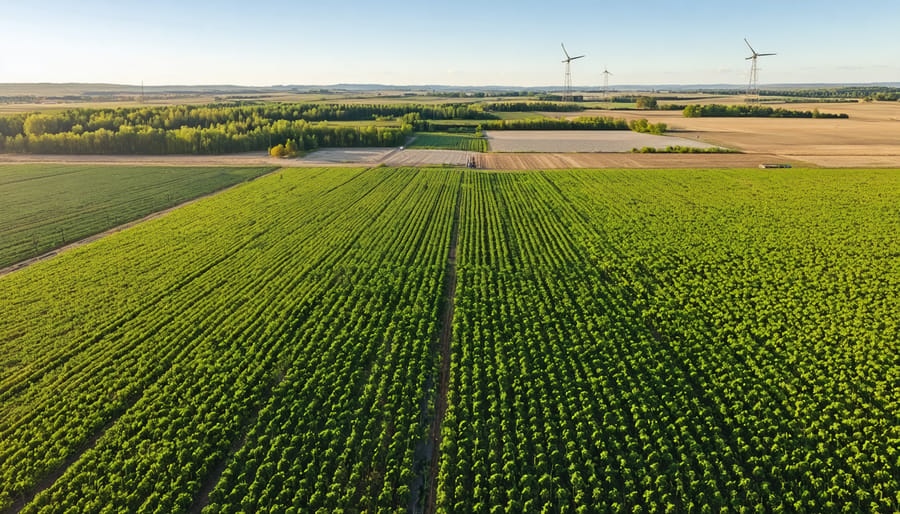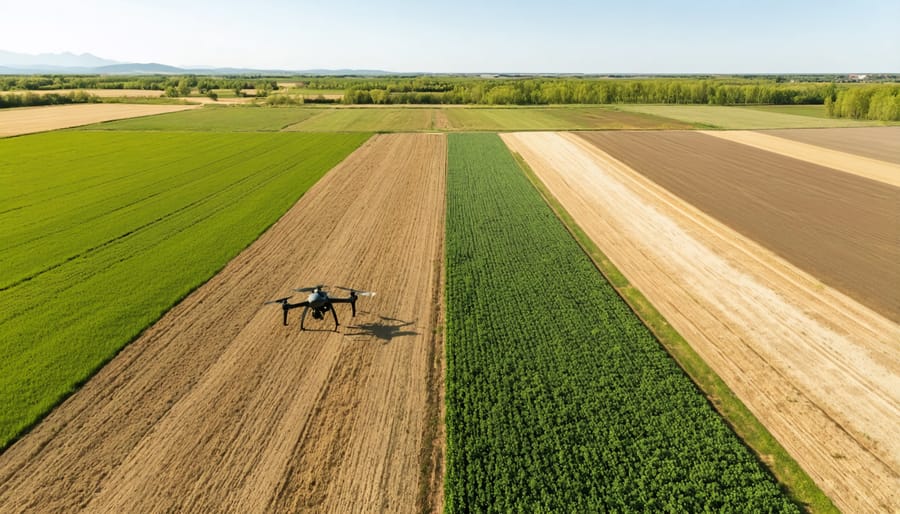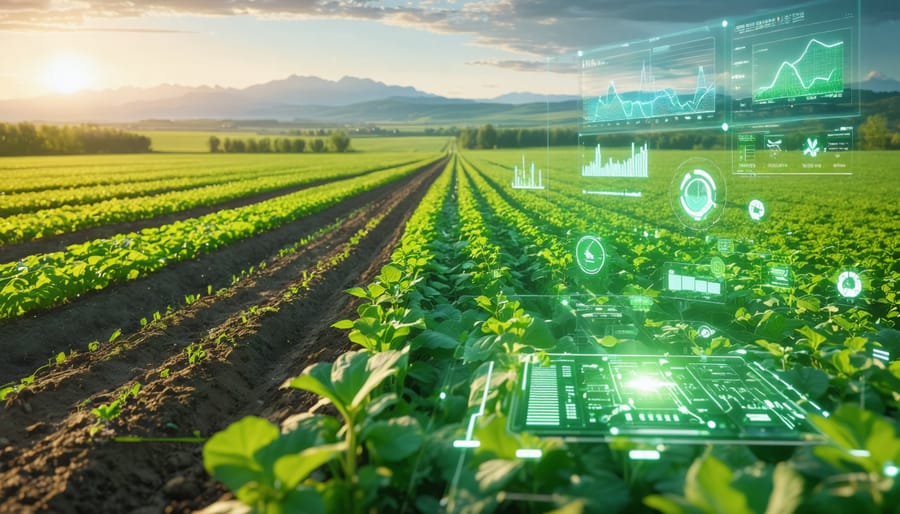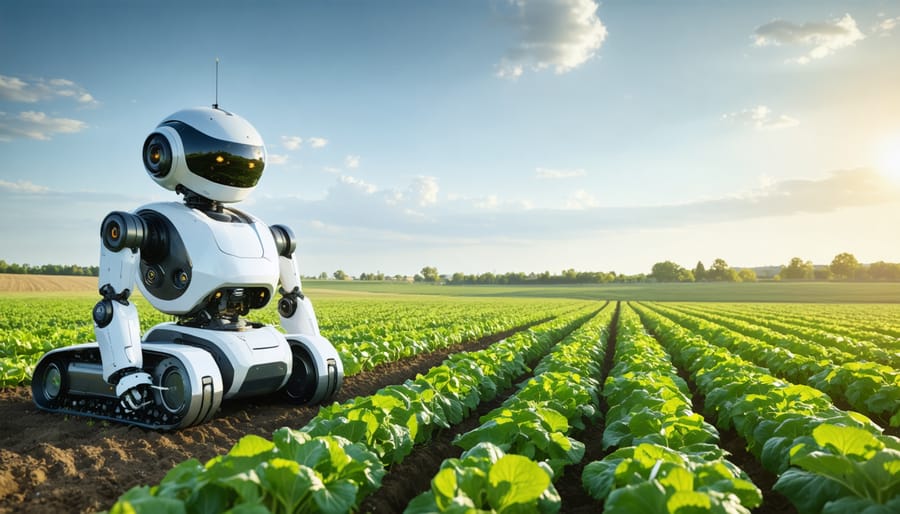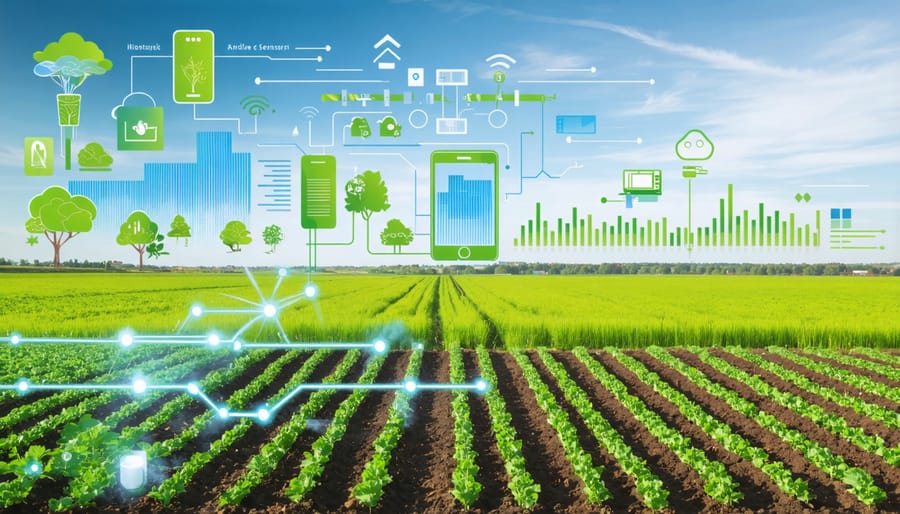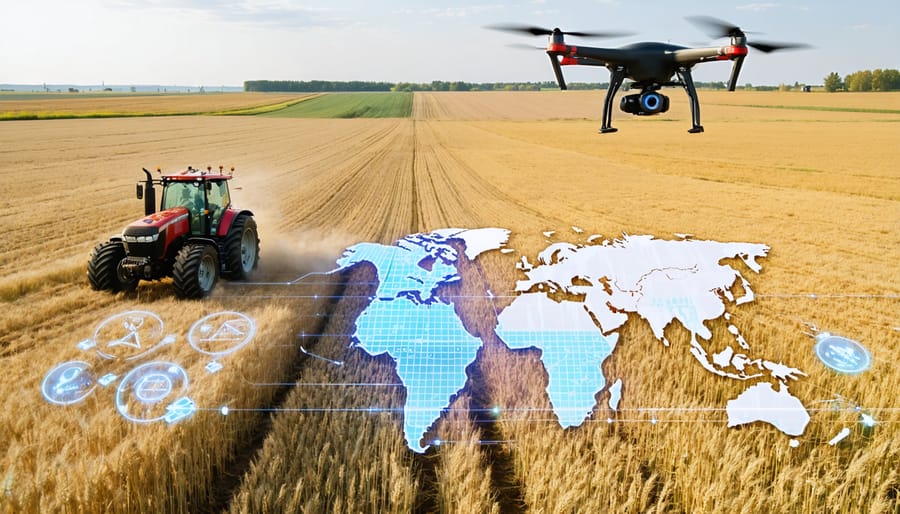The digital revolution sweeping across Alberta’s farmlands marks a turning point for Canadian agriculture. From GPS-guided tractors navigating fields with centimeter-level precision to smart irrigation systems that conserve precious water resources, technology is transforming traditional farming into a data-driven science. Local farmers are witnessing crop yields increase by up to 20% through precision agriculture techniques, while reducing input costs and environmental impact. These innovations aren’t just changing how we farm—they’re reshaping our understanding of sustainable agriculture for the next generation.
As fifth-generation farmer Sarah Thompson from Lethbridge demonstrates, combining time-tested organic practices with modern technology doesn’t mean compromising agricultural values. Her 1,200-hectare operation uses soil sensors, drone monitoring, and automated weather stations to make informed decisions while maintaining organic certification. This balanced approach has helped her farm reduce water usage by 30% and increase soil health metrics across all parameters.
What makes this technological transformation particularly relevant for Alberta’s agricultural community is its ability to address our unique challenges—from varying soil conditions to unpredictable weather patterns—while maintaining the core principles of sustainable farming that have defined our agricultural heritage.
Precision Agriculture Meets Organic Farming
GPS-Guided Equipment
GPS-guided equipment has revolutionized precision farming across Alberta’s diverse agricultural landscape. This technology allows farmers to operate their machinery with centimetre-level accuracy, significantly reducing overlap in seeding, spraying, and harvesting operations. For example, Brad Thompson, a third-generation farmer near Lethbridge, reports saving approximately 15% on input costs since implementing GPS guidance on his canola operation.
The system works by using satellite signals to create precise field maps and guide equipment along optimal paths. Modern GPS units can maintain accuracy within 2.5 centimetres, enabling farmers to plant perfectly straight rows and return to exact field positions season after season. This precision is particularly valuable during low-visibility conditions, such as night operations or dusty field work.
Beyond basic guidance, GPS systems integrate with variable rate technology (VRT) to apply resources like fertilizers and water precisely where needed. The Prairie Agricultural Machinery Institute found that Alberta farms using GPS-guided equipment reduced fuel consumption by up to 10% and decreased seed and fertilizer use by 8-12% on average.
For new adopters, many equipment dealers across Alberta offer training programs and support services. The initial investment, while significant, typically pays for itself within two to three growing seasons through reduced input costs and improved yield efficiency. Several Canadian Agricultural Partnership programs also provide funding assistance for GPS technology adoption.
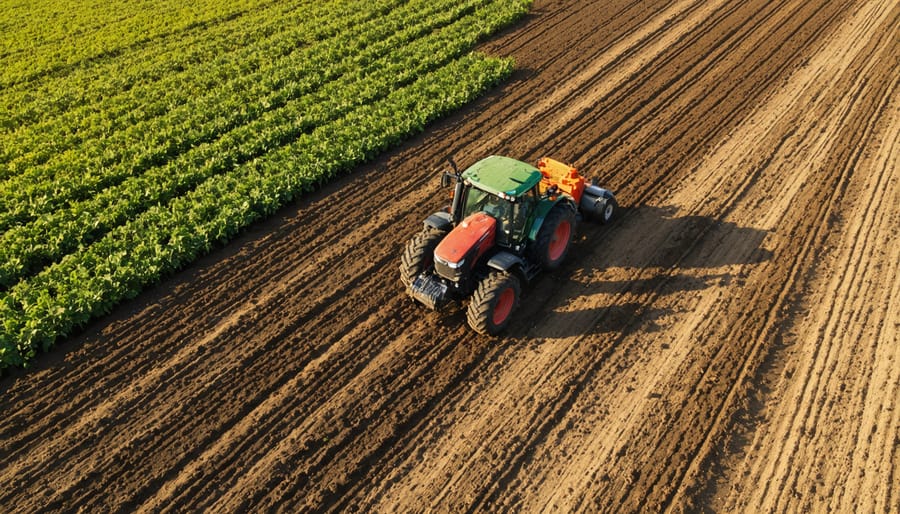
Drone Technology for Crop Monitoring
In recent years, Alberta farmers have embraced drone technology as a game-changing tool for organic crop monitoring. These aerial systems provide unprecedented visibility across vast fields, helping farmers make informed decisions while maintaining organic certification standards.
Modern agricultural drones equipped with specialized sensors can detect early signs of pest infestations, nutrient deficiencies, and water stress before they become visible to the naked eye. By implementing drone-based pest management strategies, farmers can target problem areas precisely, reducing the need for broad-spectrum organic treatments.
Sarah Thompson, an organic farmer from Red Deer County, reports that drone monitoring has helped her reduce pest control costs by 30% while improving crop yields. “The thermal and multispectral imaging lets us spot problems weeks earlier than traditional field walks,” she explains.
These drones can cover up to 160 hectares per hour, creating detailed maps that highlight variations in crop health through normalized difference vegetation index (NDVI) imaging. This technology is particularly valuable during Alberta’s short growing season, allowing farmers to maximize efficiency during critical periods.
For best results, local agricultural experts recommend conducting drone surveys every 7-10 days during the growing season, with more frequent monitoring during pest-prone periods or extreme weather conditions. The data collected helps create precise treatment maps for targeted organic interventions, ensuring resources are used efficiently while maintaining ecological balance.
Smart Soil Management Systems
IoT Soil Sensors
Modern soil monitoring techniques have revolutionized how Alberta farmers manage their land’s health. IoT soil sensors are proving invaluable for precision agriculture, offering real-time data that helps optimize resource use while maintaining organic farming principles.
These smart sensors, typically placed at various depths and locations across fields, continuously monitor crucial soil parameters. They measure moisture content, temperature, nutrient levels, and even track beneficial microbial activity. For Alberta farmers dealing with our unique climate challenges, this technology has been particularly useful in managing water resources during dry spells and preventing oversaturation during wet periods.
Local farmer Sarah Thompson from Leduc County reports a 30% reduction in water usage since implementing soil sensors across her 400-hectare organic farm. “The sensors alert me when specific zones need attention, rather than relying on broad irrigation schedules,” she explains.
The systems typically include:
– Moisture probes that measure water content at different soil depths
– NPK sensors tracking essential nutrient levels
– pH monitors for soil acidity
– Temperature sensors for optimal microbial activity
– Salinity meters to prevent mineral buildup
Most systems connect to smartphone apps, providing instant alerts and historical data trends. This allows farmers to make informed decisions about irrigation timing, nutrient application, and soil amendment needs, all while maintaining organic certification requirements.
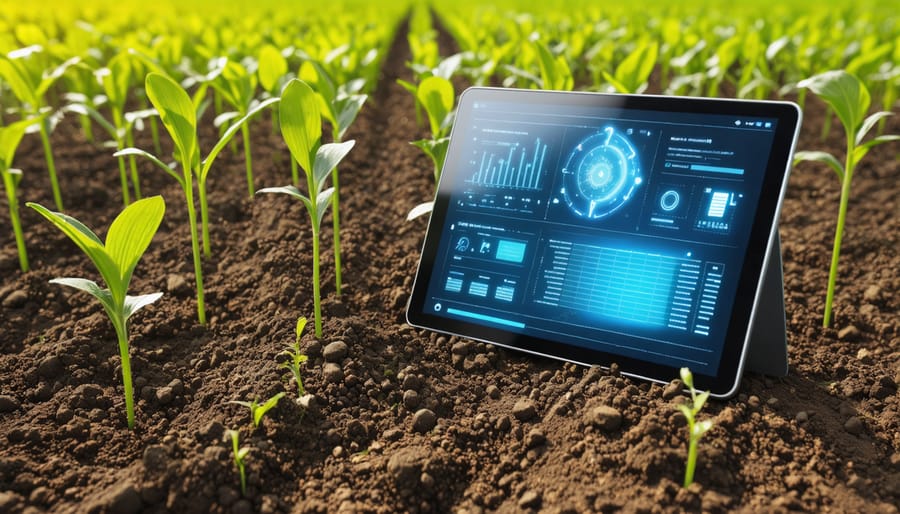
AI-Powered Nutrient Management
The integration of AI-powered nutrient management systems has revolutionized how organic farmers approach fertilizer application in Alberta. These smart systems analyze soil composition, crop health, and environmental conditions in real-time, enabling precise and efficient use of organic fertilizers.
Local farmer Sarah Thompson from Red Deer County has seen remarkable results using AI soil monitoring sensors across her 800-hectare organic farm. “The technology helped us reduce organic fertilizer usage by 30% while maintaining yield quality,” she notes. The AI system she uses combines data from soil sensors, weather stations, and satellite imagery to create detailed nutrient maps, ensuring optimal distribution of composted manure and other organic amendments.
The technology particularly shines in variable rate application, where AI algorithms adjust fertilizer rates based on specific field conditions. University of Alberta research shows that AI-guided nutrient management can increase nitrogen use efficiency by up to 25% in organic systems, leading to both environmental and economic benefits.
For farmers new to this technology, the Alberta Organic Producers Association offers workshops on implementing AI nutrient management systems. These programs focus on practical applications, helping farmers understand how to interpret AI-generated recommendations while maintaining organic certification requirements.
The initial investment in AI technology is offset by reduced input costs and improved crop quality. Many Alberta farmers report complete return on investment within two growing seasons.
Alberta Success Stories
The Thompson Family Farm
Located just outside of Olds, Alberta, the Thompson Family Farm stands as a shining example of how traditional organic farming can embrace modern technology without compromising its core values. Three generations of Thompsons have worked this 400-hectare operation, which has successfully integrated smart farming solutions while maintaining their organic certification for over 25 years.
In 2019, Sarah Thompson, the youngest generation of farmers, spearheaded the implementation of IoT sensors throughout their fields. These sensors now monitor soil moisture, temperature, and nutrient levels in real-time, allowing for precise irrigation scheduling and reduced water usage. The farm also employs drone technology for crop monitoring, helping identify potential issues before they become significant problems.
“Technology doesn’t have to conflict with organic principles,” explains Sarah. “It’s about using these tools to make better decisions while respecting the land.” The farm’s automated weather station connects with their smartphone app, enabling the family to make data-driven decisions about planting and harvesting schedules.
Perhaps most impressive is their custom-built tracking system that monitors crop rotation patterns and soil health across multiple seasons, ensuring compliance with organic standards while maximizing yield potential. The Thompsons’ success has inspired neighboring farms to explore similar technological integrations.

Prairie Organic Cooperative
The Prairie Organic Cooperative, launched in 2021 in central Alberta, represents a groundbreaking approach to modernizing organic farming through shared resources and collective knowledge. This innovative partnership between 45 organic farmers demonstrates how community collaboration can make advanced agricultural technology more accessible and sustainable.
Members pool resources to purchase sophisticated equipment like GPS-guided tractors and drone surveillance systems, which might otherwise be cost-prohibitive for individual farms. Through their equipment-sharing program, farmers can access over $2.5 million worth of technology while paying only a fraction of the cost.
The cooperative also maintains a digital knowledge bank where members share real-time data about soil conditions, weather patterns, and crop performance across different regions. This collaborative approach has resulted in a 30% increase in crop yields among member farms over the past two growing seasons.
Monthly tech workshops bring members together to learn about new farming technologies and share practical implementation strategies. The cooperative’s mentorship program pairs tech-savvy farmers with those looking to modernize their operations, ensuring that traditional organic farming wisdom integrates seamlessly with new technologies.
The success of this model has inspired similar initiatives across the Prairie provinces, showcasing how community-based approaches can accelerate technological adoption in organic farming.
Getting Started with Farm Tech
Cost-Effective Solutions
Implementing new farming technology doesn’t have to break the bank. Many Canadian farmers are finding success with phased approaches to technological adoption, starting with essential tools that offer the highest return on investment. For example, soil moisture sensors and basic GPS guidance systems typically cost between $2,000 to $5,000 but can reduce water usage by up to 30% and fuel costs by 15%.
The Canadian Agricultural Partnership (CAP) offers grants covering up to 50% of technology investments for qualifying farmers. In Alberta specifically, the Environmental Stewardship and Climate Change Producer Program provides funding of up to $100,000 for precision agriculture equipment that promotes sustainable farming practices.
Local agricultural co-ops are increasingly offering equipment-sharing programs, allowing members to access expensive technology like drones and automated seeders at a fraction of the ownership cost. The Southern Alberta Equipment Share Program, for instance, has helped over 200 farmers access modern farming equipment through their cost-sharing initiative.
Free or low-cost mobile apps are also revolutionizing farm management. Weather tracking, crop monitoring, and market price apps can significantly improve decision-making without major investment. Many agricultural extension offices offer free training on these digital tools.
Consider starting with one or two key technologies that address your farm’s biggest challenges. According to the Alberta Agriculture Technology Centre, most farmers see positive returns within two growing seasons when they prioritize solutions that tackle specific operational inefficiencies rather than implementing multiple systems at once.
Implementation Strategy
Implementing new technologies while maintaining organic certification requires a systematic approach. Start by conducting a thorough assessment of your current farming operations and identify specific areas where technology can enhance efficiency without compromising organic standards.
Create a detailed implementation timeline spanning 12-18 months, allowing for proper training and gradual integration. Begin with low-risk technologies like GPS-guided tractors or automated irrigation systems, which have minimal impact on organic certification requirements.
Before purchasing any equipment, consult with your organic certifying body to ensure compliance. Document all proposed changes and maintain clear communication throughout the process. Many Alberta farmers have found success by starting with soil monitoring sensors and weather stations, as these tools support organic practices while providing valuable data.
Form partnerships with local agricultural technology providers who understand organic requirements. Consider joining technology-sharing cooperatives, which are becoming increasingly popular in central Alberta. These arrangements can help reduce initial costs and provide valuable peer support during the transition.
Implement regular staff training programs to ensure proper technology usage. Start with small pilot projects on designated fields before expanding across your entire operation. This approach, successfully used by several certified organic farms in Red Deer County, allows for adjustments while maintaining certification standards.
Monitor and document all results, including soil health indicators, yield data, and resource efficiency metrics. This information will be valuable for both certification renewal and future technology integration decisions.
The integration of technology in organic farming represents a significant step forward for Canadian agriculture, particularly here in Alberta. As we’ve seen through numerous local success stories, farmers who embrace these innovations while maintaining organic principles are experiencing improved yields, reduced labour costs, and enhanced sustainability in their operations.
The future of organic farming looks increasingly bright as new technologies continue to emerge and evolve. From precision agriculture tools that help conserve water to AI-driven pest management systems, these advancements are making organic farming more efficient and accessible than ever before. Our local agricultural community has demonstrated that technology and organic principles can work hand in hand, creating a more resilient and productive farming sector.
Looking ahead, we can expect to see even more exciting developments in areas such as soil health monitoring, automated weeding systems, and climate-smart farming practices. The key to success lies in thoughtful implementation, community knowledge sharing, and maintaining the core values of organic farming while leveraging these new tools.
For Alberta farmers considering the transition to tech-enabled organic farming, the investment in appropriate technology can lead to long-term benefits, including improved soil health, better crop yields, and increased farm profitability. As our agricultural sector continues to evolve, the combination of traditional organic practices and modern technology offers a promising path forward for sustainable farming in our region.
Remember, every step toward technological integration, no matter how small, contributes to the broader goal of creating a more sustainable and efficient agricultural future for Alberta and Canada as a whole.


